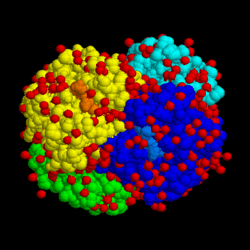Conjugated protein


A conjugated protein is a protein that functions in interaction with other (non-polypeptide) chemical groups attached by covalent bonding or weak interactions.
Many proteins contain only amino acids and no other chemical groups, and they are called simple proteins. However, other kind of proteins yield, on hydrolysis, some other chemical component in addition to amino acids and they are called conjugated proteins. The nonamino part of a conjugated protein is usually called its prosthetic group. Most prosthetic groups are formed from vitamins. Conjugated proteins are classified on the basis of the chemical nature of their prosthetic groups.
Some examples of conjugated proteins are lipoproteins, glycoproteins, phosphoproteins, hemoproteins, flavoproteins, metalloproteins, phytochromes, cytochromes and opsins.
Hemoglobin contains the prosthetic group containing iron, which is the heme. It is within the heme group that carries the oxygen molecule through the binding of the oxygen molecule to the iron ion (Fe2+) found in the heme group.
Glycoproteins are generally the largest and most abundant group of conjugated proteins. They range from glycoproteins in cell surface membranes that constitute the glycocalyx, to important antibodies produced by leukocytes.
References
Nelson DL, Cox MM (2005). Lehninger's Principles of Biochemistry (4th ed.). New York, New York: W. H. Freeman and Company.